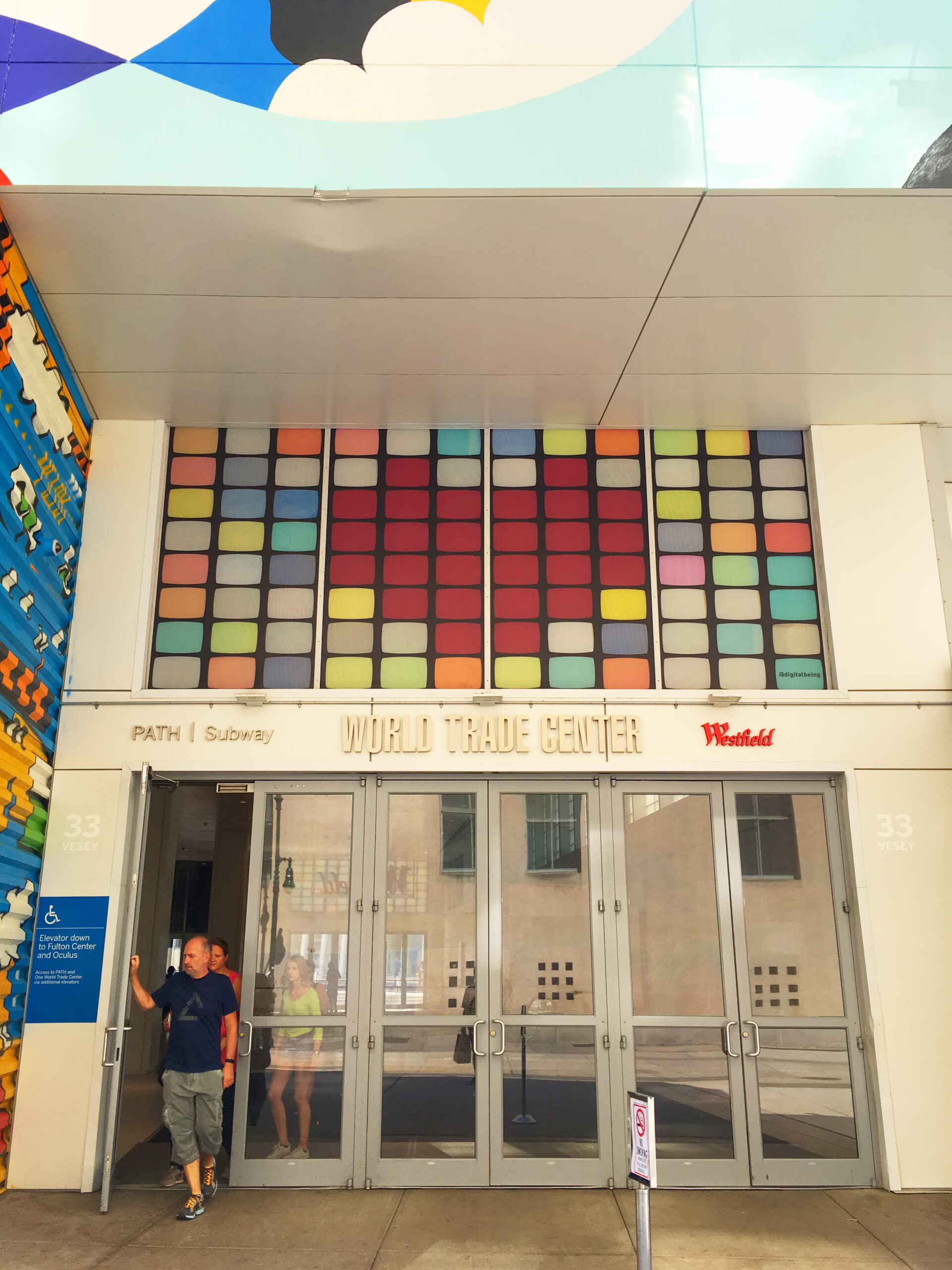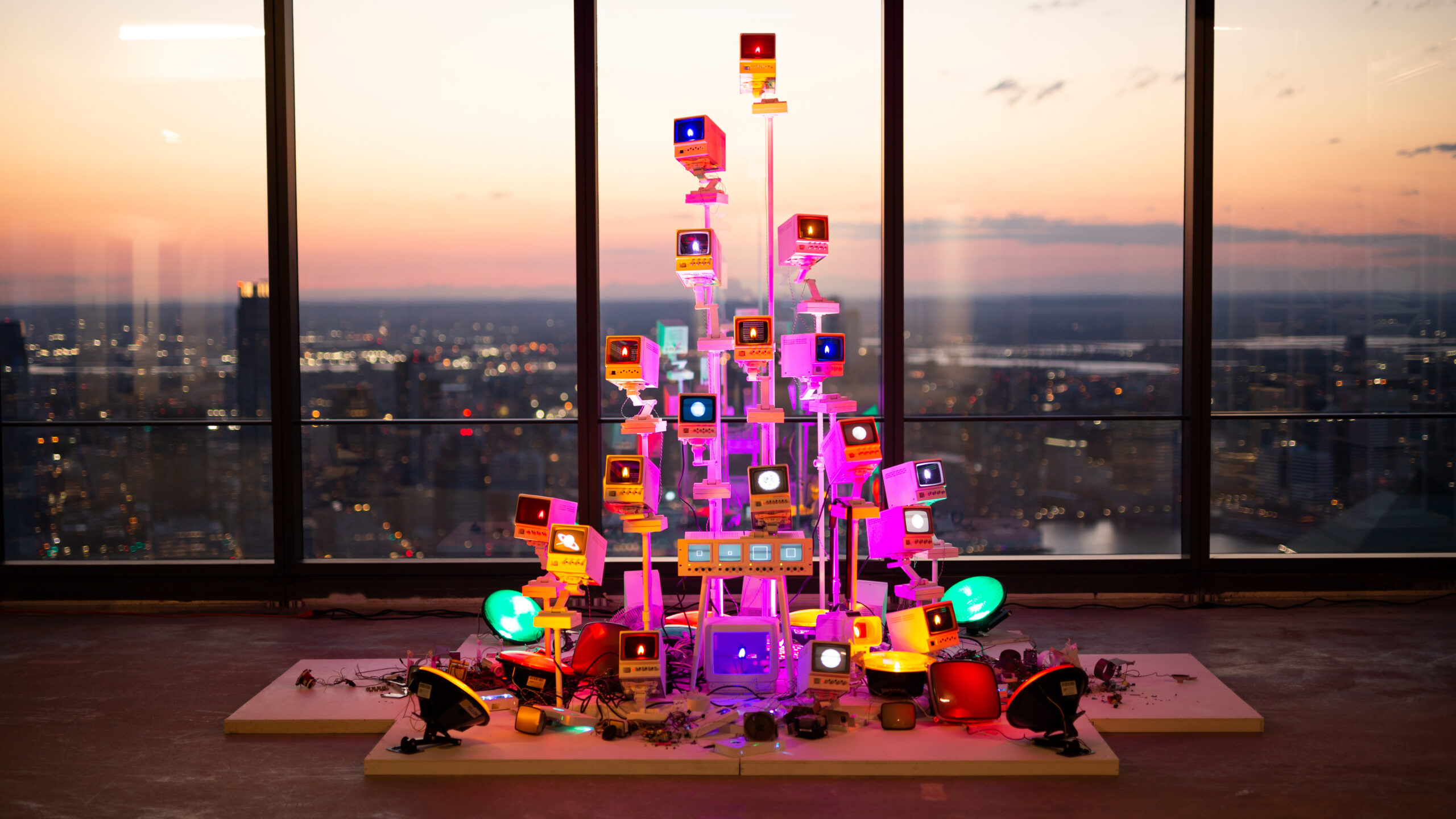Long before there were stores like Best Buy and RadioShack, if New Yorkers wanted to buy electronics, they would go to Radio Row, a 13-block stretch along the Lower West Side. That shuttered in the 1960s; today, overlooking that bygone site, on the 69th floor of 3 World Trade Center (3 WTC), there is a studio filled with old transistors and tubes from the analog era, radically transformed into colorful and sprawling artworks through modern digital technology.
These machines were reimagined by the video artist Taezoo Park, visiting instructor of digital arts at Pratt Institute, who earned his MFA in the program in 2012.
Park is a Korean-born creative working in the tradition of trailblazing artist Nam June Paik (1932–2006), who created globally acclaimed video art and television sculptures in the late 20th century. As he has built his career, Park has apprenticed with one of Nam June Paik’s colleagues, engineer C.T. Lui, to study and archive the artist’s work, a position that continues to deeply inform his practice.
But Park has a style all his own, constantly drawing historical connections from his physical environment into his interactive digital works.
“I’m planning to make a project in one of the old Radio Row storefront spaces,” Park says. “Silverstein Properties, the owner of WTC, offered me the storefront space of their 120 Broadway building. Right now, I’m hoping to display the public domain version of Mickey Mouse watching himself, digitally transformed.” (The copyright for the 1928 version of Mickey expired this year.)
When he arrived in New York City in 2008 to attend Pratt, it was a year before the broadcast transmission system went digital, and analog televisions were being thrown away. Park, who was deeply involved in the city’s interactive art community, saw this as an artistic opportunity. “People got to know me as the guy collecting these machines from the street,” he says.
As a student, he began work on Digital Being, a sculpture he conceived as an unknown creature born from abandoned analog and digital technology. In 2016, Park was invited to install this piece in the World Trade Center, alongside works by contemporaries like his classmate and fellow digital arts graduate Joohee Park, MFA Digital Arts ’12, who creates murals under the moniker Stickymonger. He was invited to have a studio space in 3 WTC in 2023.
Today, Park’s work can be found throughout the city, such as Tower-1, temporarily installed in the Italian luxury brand Gucci’s new SoHo location.
Last semester, Park returned to Pratt’s Digital Arts Department to teach, conducting an electronic art course called Physical Computing. As an instructor, Park aims to help students find creative applications for whatever environment they’re working in. Take, for example, his analog television sculpture Building-1. This kaleidoscopic stack of glowing televisions is currently installed in 7 World Trade Center, where it bears a striking resemblance to the headquarters of Goldman Sachs right out the window behind it. At night, Park notes that the blinking screens give “the illusion from a distance that the machines are breathing” with the Goldman Sachs building. “I always try to adjust myself to the situation,” says Park. “Right now, the World Trade Center is the environment I am surrounded by, and I need to find solutions for how to use the space wisely. I cannot teach with a certain manual, but I can teach how to look for solutions.”
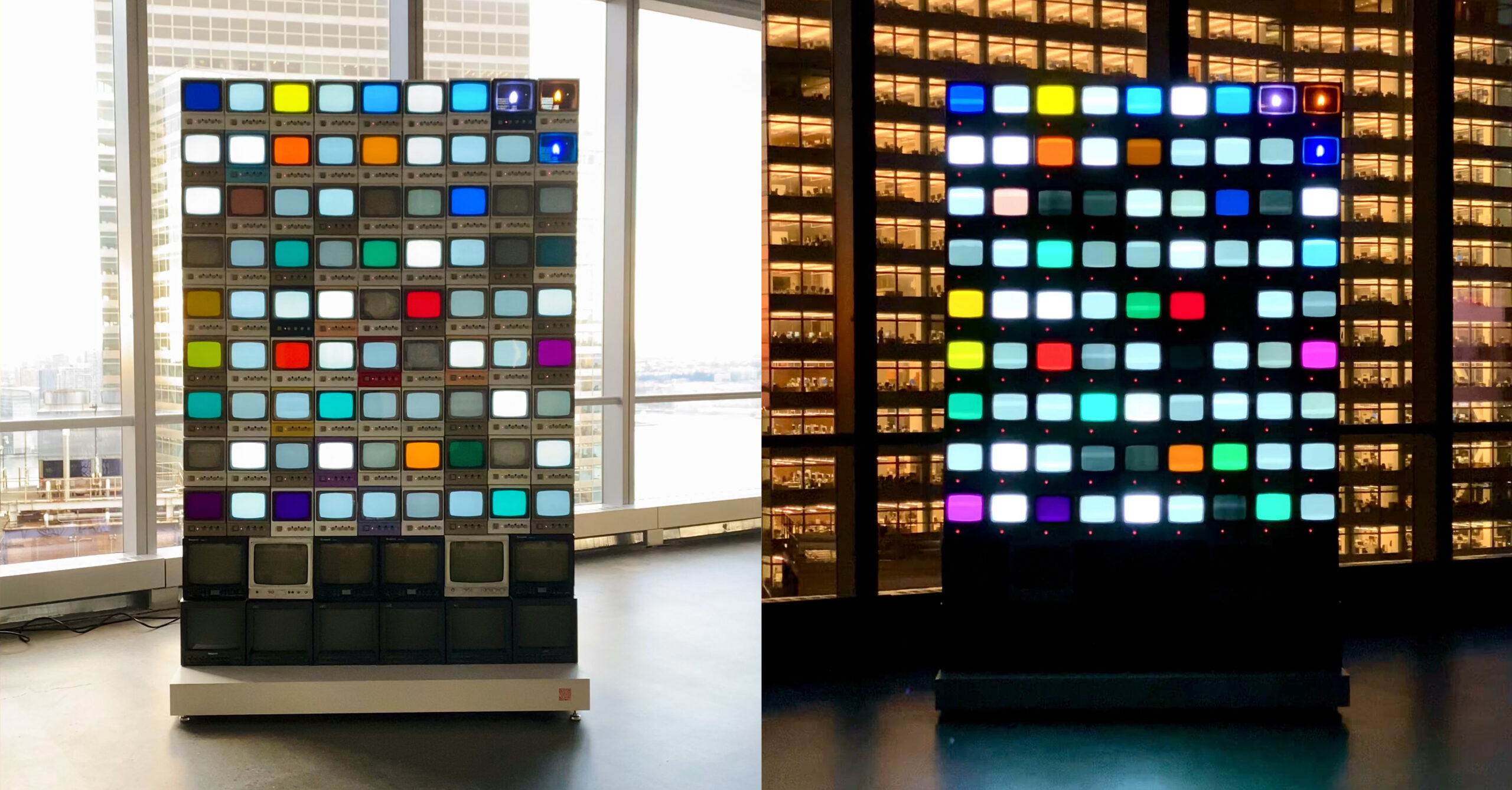
The following Q&A has been edited and condensed.
How did you begin thinking about blending digital and analog technologies?
I was born in 1979 in Ulsan, South Korea. My hometown was referred to as “industry city” back then. It has become a clean industrial city and a good place to live, but at the time I was born into a factory environment. I remember when I’d go to the terrace of my apartment, if the direction of the wind would change, it would sometimes deliver the pollution from the factory to me. The people of my hometown were always looking for the most efficient thing, and there was no place for culture to grow.
At the same time, everyone loved television. I was one of those kids who liked to watch a lot of videos. I have a lot of memories attached to televisions. How they worked, I had no idea, but I would just enjoy their contents. These memories inspired me to study animation as an undergraduate at Hong-Ik University.
While I was there, I became obsessed with the latest digital technologies, like [the 3D computer graphics application] Maya, which was very difficult to use, because the rendering speed was very slow back then. There were developers, software engineers, and scientists trying to figure out how to make it more efficient and reliable, but there were still errors and lots of bugs. I became really interested in fixing these bugs, and how to maintain these new technologies.
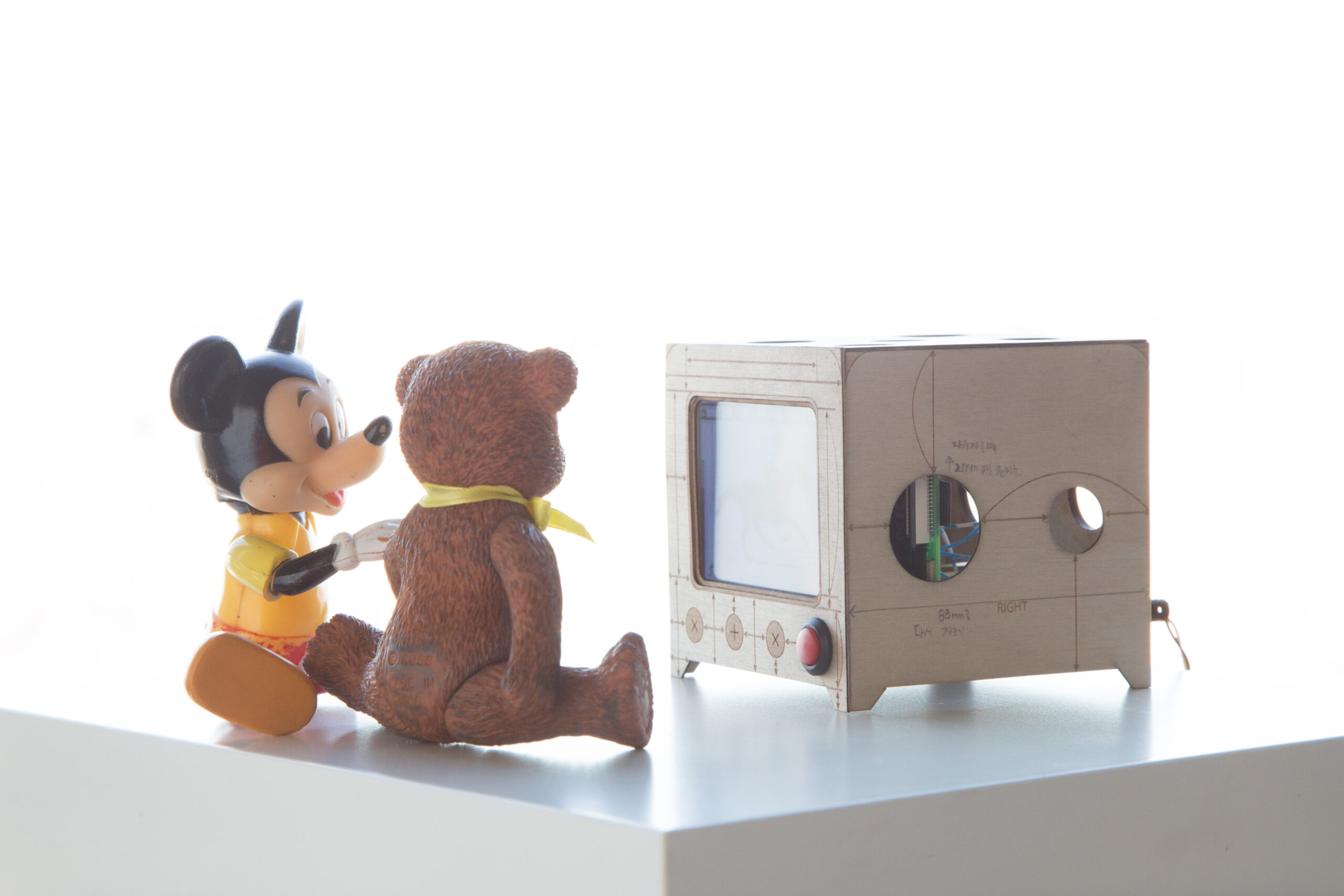
I believe these experiences led me to my current practice. They are part of why I created this sculpture, Square Eyed, where this touch screen is in a box shaped like an analog television. The bear is my brother and this Mickey Mouse is me. I wanted to preserve my memories of using these analog machines using the latest digital technology.
When did you begin collecting analog televisions?
In 2008, I came to New York City to study at Pratt for my master’s degree. I got to know the cathode ray tube (CRT) television as an iconic piece from the father of video art, Nam June Paik. His career started in 1963, when he had his first solo show in Germany. He moved to New York City and built a whole career, even though no one cared about video art back then! (Laughs.)
But when I came to New York, the broadcast transmission system became digital and this iconic piece of technology from back then was abandoned. These CRT parts can be recyclable, but nobody wanted to recycle them because it isn’t cost effective. These parts are full of lead and other very toxic materials, and many were shipped to the third world, where they extracted materials without any protections. If the television was not working or resellable, it would be thrown away. Then the water and soil are polluted, like my old hometown used to be. I had to imagine, how many CRTs will be abandoned this way?
So I started to collect some of them, and found that half of them were working and half of them were not. I combined digital technology like Arduino, a kind of integrated circuit (IC) chip that can control the original function of the machine, hook up sensors, and connect with outputs. I realized I could give new lives to these opendata machines.
How did your time at Pratt help you to refine these concepts?
When I came to New York City, I thought I was going to work as an animator for one of those awesome companies like Pixar. I felt like animation was a good tool to deliver my story very linearly. But I quickly discovered I liked delivering my story no matter the format or media. When I started in the Digital Arts Department at Pratt, I got to learn about interactive, real time, and nonlinear media, which was more aligned with my obsession with new digital technologies.
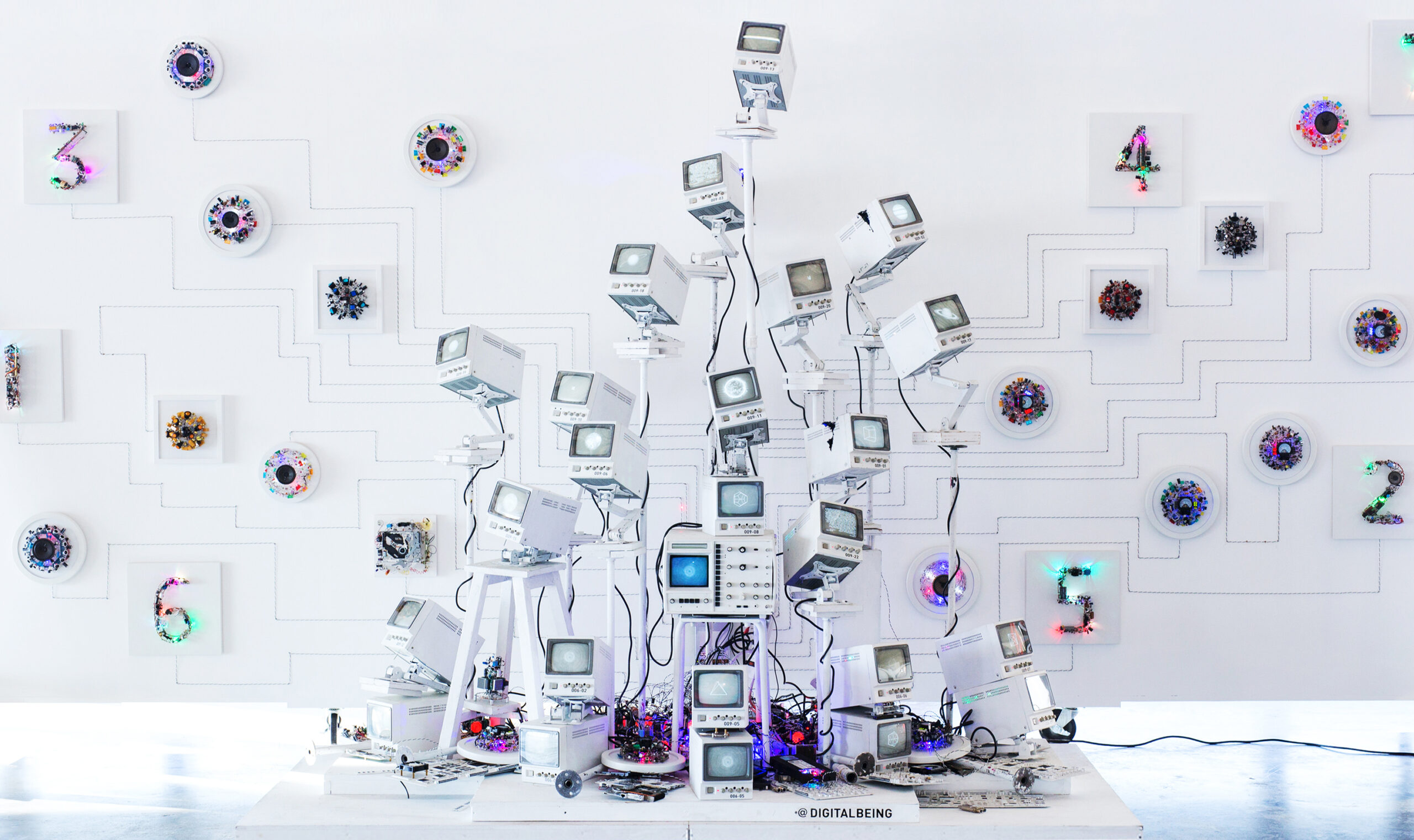
I had several professors who were influential to me. The former chairperson of the Digital Arts Department, Peter Patchen [associate professor of digital arts], gave me a reference book when I began to think about working with abandoned technology, and was developing work that would later become Digital Being. The book’s title is Being Digital. It’s by Nicholas Negroponte, who was one of the founders of the MIT Media Lab. The book was published in 1996, just before the rise of the internet. In it, he describes how we used digital technology to build our contemporary societal infrastructure over what had already been created. All of these concepts I was thinking about were inside of the book. I got to know what digital technology can do, and I just developed my ideas more and more.
Professor Liubomir Borissov [associate professor of digital arts] taught me how to actually build Digital Being in his Physical Computing class. I really admire him—I can tell he’s a genius. And Professor Linda Lauro-Lazin [assistant chair of digital arts, adjunct professor (CCE)] gave me artistic references like Perry Hoberman, who created some very interesting interactive installations in the ’90s like Faraday’s Garden, where he had a switch in the floor and when someone would come in, the machines would begin to move in the space.
I also have to mention Professor Michael O’Rourke [professor emeritus of digital arts]. When I developed this concept of Digital Being, he asked me what kind of characteristics a “digital being”—as a literal new lifeform—would have. I became obsessed with this question. He mentioned that it might be like a cockroach or an ant existing in our world, that we don’t interact with that much. They could do what they’re doing in their own ecosystem. It made me think about how I could use sensors, like Perry Hoberman, to create the effect of a digital being that is working on its own without any interaction.
My department at Pratt gave me the solutions to create Digital Being, technically and conceptually. I think technology is very easy to make these days using AI, but developing a concept and idea is more important than technology. I also needed to know the technical fundamentals, and Professor Borissov helped me with that, but if no professor had mentioned these influential books or artists, I could have never made this artwork.
As you were growing these conceptual ideas, how did you begin archiving the work of Nam June Paik?
Since I started collecting machines from the street, people got to know me as this collector, and began to donate their materials to me. I was still working with these machines, mostly CRT televisions, after graduation.
Professor Borissov connected me to a part-time job creating a project with augmented reality technology, where I got to know the artist Raphaele Shirley. A few years after I graduated in 2012, Shirley contacted me all of a sudden. It turned out she was one of the last assistants of Nam June Paik, and she was helping to maintain his artwork with the engineer and technician C.T. Lui.
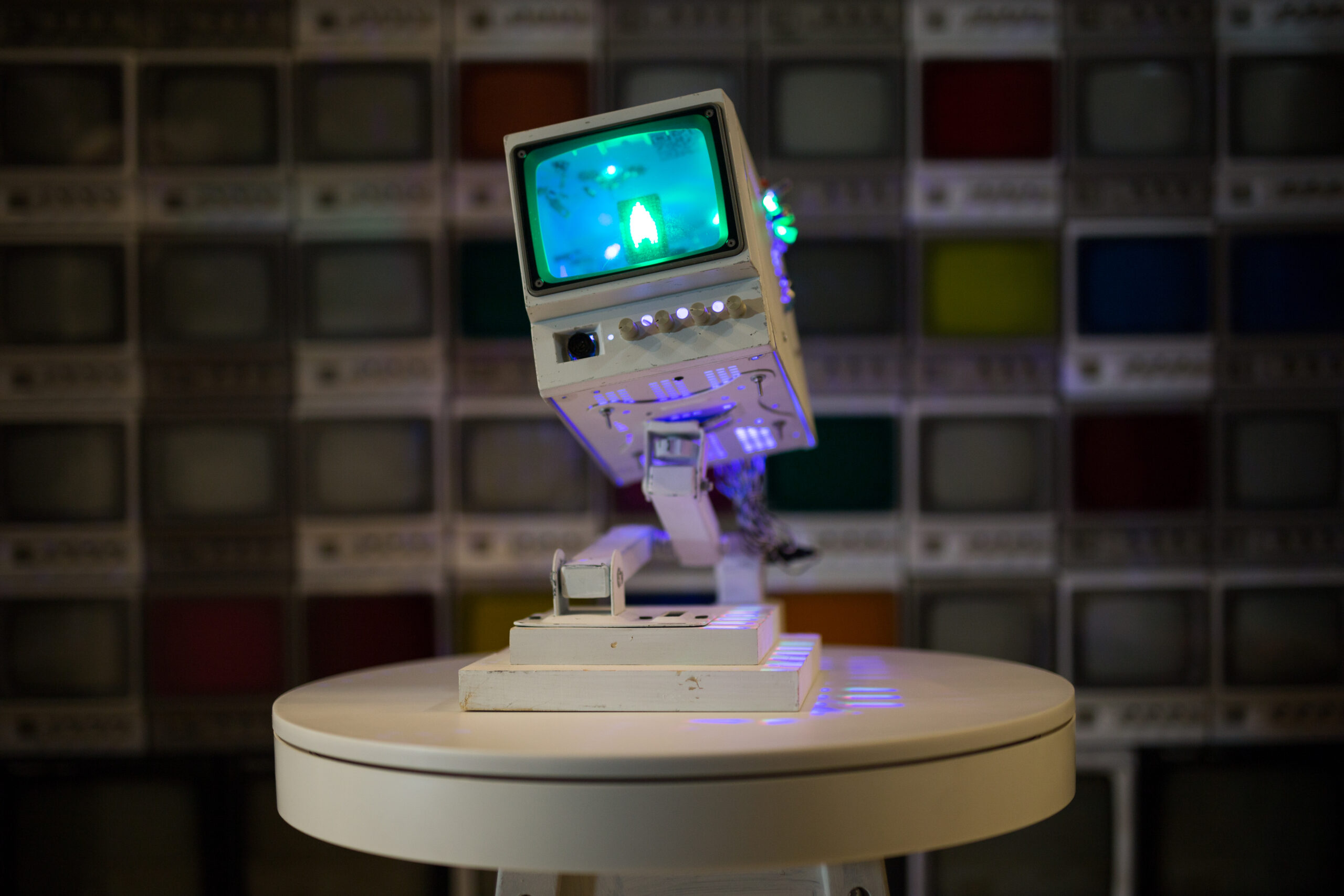
C.T. Lui met Nam June Paik one day in 1969, when [Paik] went into his shop, C.T. Electronics, with a handheld camera he needed to get fixed. They got to know each other, and they became good friends very easily—Lui tells this story in an interview with PBS as part of a broadcast on Paik. They also featured an interview with me in this documentary, discussing my work as Lui’s apprentice. Paik needed a technician to help set up his work in museums when he became famous. Whenever any museum in New York wanted to show Paik’s artwork, C.T. Lui would prepare the show. He still does, including the latest one in 2018 at the Whitney.
I didn’t know those kinds of jobs existed! Raphaele Shirley asked me if I was interested in doing this kind of job. A couple of years later, I met Lui in person—he had been observing my work for a long time, wondering if I was only here temporarily, without any passion about the job. He invited me to his workshop and I began to work more seriously. His workshop is a paradise of old electronic machines. These were very expensive—you could buy a house instead of buying some of these machines, and he picked the machines.
Having started teaching this last semester, how have you brought your art practice and archival work into the classroom?
I am grateful to the current Chair of Digital Arts and Animation, Douglas Easterly, for giving me the opportunity to share my experiences with students. I can teach fundamentals, but mostly I want to share my knowledge from having shows from 2012 until now, and how I’ve survived as an artist. I can share knowledge about how to properly install an artwork and communicate with galleries who don’t care, while also keeping your works’ originality. I’ve been there for a long time. Not a long time compared to C.T. Lui, but for over 10 years.
Last year, we got the new tool ChatGPT. More versions of that are going to come from other brands, and the artists who are dealing with this technology are getting ready to explore more. Digital artists don’t have to just focus on coding and basic things. Some people want to start from scratch, and other people want to play with the tools available to them. I want to integrate this technology as a tool and an art medium, and [think about] how to use it and adjust the function as a tool in my students’ artwork.
When I was a student, over 10 years ago, I was focusing on how to build one block of code at a time, one by one. When it was not working, I’d just say, “Forget it! It’s not worth it!” I had a lot of imagination and cool ideas that I couldn’t fully realize. These days, I’m going to teach those fundamentals [of coding] and how to properly use AI as a tool to sort through big data—as a way for students to keep developing their stories.
